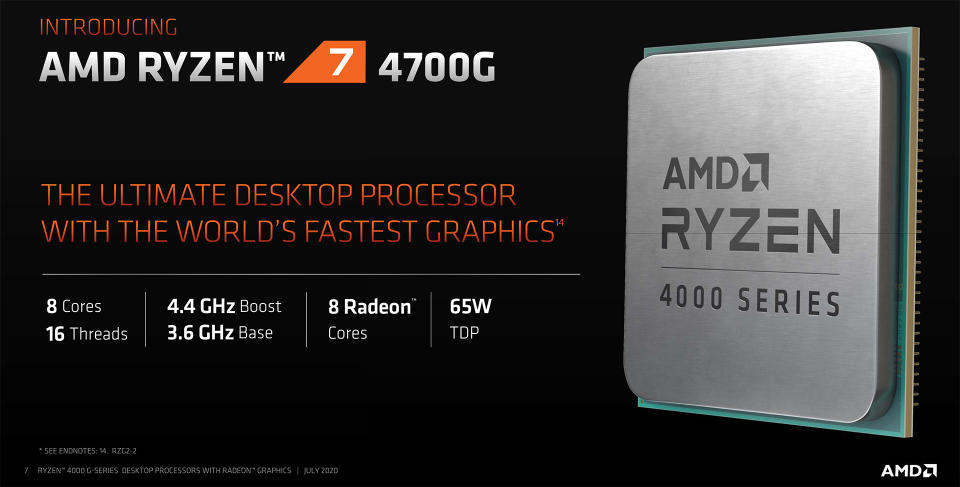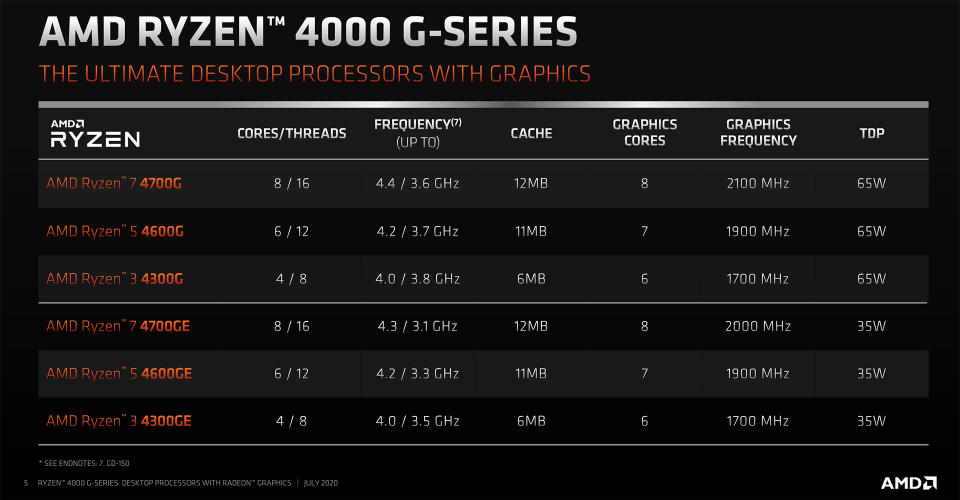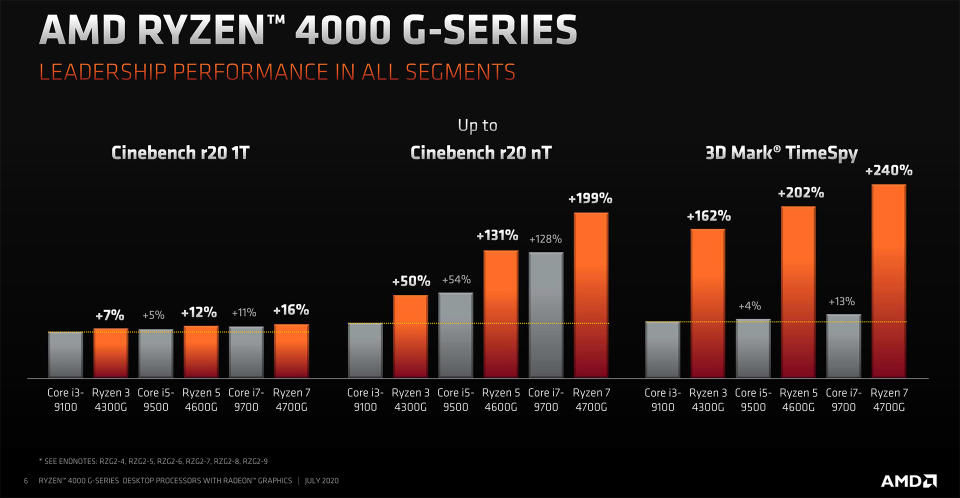AMD's 4700G APU is a mid-range PC on a single chip
The long-awaited replacement to the 3400G is here.
It's been a year since AMD's Zen 2 Ryzen 3000 CPUs changed the desktop PC market, with best-in-class productivity and "good enough" gaming performance. More recently, we've seen those same Zen 2 cores start making their way into laptops, with some stunning results. One area has been left behind, though: desktop APUs, which combine a processor with integrated graphics. Today that changes, as AMD is announcing a family of "4000G" APUs for desktop PCs.
First, some clarification: Confusingly, AMD's current 3000G series APUs, which top out at the 4-core/8-thread 3400G, are based on the company's last-generation Zen+ cores, as seen in the 2000 series desktop chips. These new 4000G chips, just like the 4000-series laptop chips, are related to the 3000-series desktop chips. This will get more confusing when the company's unannounced-but-imminent 4000 series desktop CPUs hit the market later this year with "Zen 3" cores.

There are three new 4000G APUs to cover in today's announcement, each available in two configurations. The flagship model is the 8-core/16-thread Ryzen 7 4700G, which has a base clock of 3.6GHz and a (single-core) boost clock of 4.4GHz. These core/thread counts and frequencies are identical to the Ryzen 7 3700X desktop chip. Being an APU, the 4700G also has graphics cores -- eight of them to be precise -- with a maximum frequency of 2100MHz.
Next down the line is the 6-core/12-thread Ryzen 5 4600G, with a base clock of 3.7GHz and a boost clock of 4.2GHz, which is broadly equivalent to the Ryzen 5 3600 CPU. The 4600G has 7 graphics cores running at up to 1900MHz.
The range is rounded out by the 4-core/8-thread Ryzen 3 4300G. With a base clock of 3.8GHz and a boost clock of 4.0GHz, performance should land somewhere between the Ryzen 3 3100 and 3300X. It has 6 graphics cores running at 1700MHz.
All three chips, in this configuration, have a listed TDP of 65W, which is the same as the equivalent Ryzen 3000 CPUs. (It's worth noting that this doesn't really have much bearing on how much power they'll actually draw.) Each APU also comes in a "GE" flavor, which is a low-power version rated at 35W, with significantly lower frequencies across the board but no changes beyond that.

On paper, these new APUs look extremely competitive. The 3000G chips they replace struggle when compared to even budget CPUs. The jump to Zen 2 alone will be a major improvement, as clock-for-clock these cores are close to 15-percent stronger than Zen+. The added cores and threads of the two higher-end chips, though, make them a compelling option for someone looking to build a workstation-like PC on a tight budget. In fact, they change who we would recommend even considering purchasing an APU in the first place.
While the 3400G is a decent single-chip solution for people on an extremely tight budget, it doesn't leave much room to improve your PC down the line, especially as in regards to gaming, as anything beyond budget GPU options would be wasted. With the 4700G and 4600G, though, you could build a PC without shelling out any money on a graphics card, and then add pretty much any discrete GPU you wanted down the line to turn your PC into an extremely performant gaming rig. The Ryzen 7 3700X, which is broadly equivalent to the 4700G, can be sensibly paired with any high-end GPU on the market.

As for the performance of the integrated GPUs, things look extremely promising. Assuming proper cooling, the 4700G's 8-core GPU should hit 2.1TFLOPs, which is 50-percent more raw compute performance than the 3400G can muster. That should be more than enough to play esports titles at 1080p, and just about hits the minimum spec for Death Stranding.
One thing worth noting is that, without dedicated video memory, the performance of the integrated GPU is tied to the speed and amount of system RAM you have. Ryzen CPU performance is already quite reactive to RAM speed, but you'd likely be wanting to pair the 4700G with 16GB of some decent 3600MHz DDR4 RAM — or very low-latency 3200MHz memory. This will give the GPU a fighting chance of running more demanding games well, but will also add to the cost of your overall build compared to slower RAM.
Of course, this is all "on paper;" we'll have to judge for ourselves how well these new APUs hold up in the real world. The 4000G series should start appearing in pre-built desktops next month. We don’t have a date for a retail launch just yet, but we expect it won’t be too far behind. The other thing we're waiting on is pricing, which will be key given the price-conscious consumers APUs are typically targeted at. If we had to guess, we'd suggest a starting point of around $140 for the 4300G, stretching up to around $300 for the 4700G.
